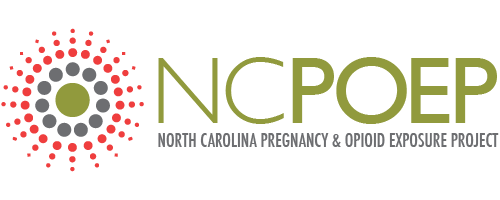Introduction and Purpose
A multidisciplinary working group of stakeholders from across North Carolina met in fall 2012 to discuss opioid use in pregnancy. In recent years, the rates of opioid-exposed pregnancies have risen sharply across the state, and stakeholders from medical, behavioral health, child welfare, and justice have shared the multiple challenges they have faced with this increasing prevalence. This guidance document presents the result of the stakeholders identifying a need for quality, comprehensive information on the topic of pregnancy and opioid exposure that is suitable for the wide variety of professionals who serve women and their families.

A variety of life experiences can lead to opioid-exposed pregnancies. Some of the more common pathways include women with active addictions to opioids, and who may or may not be receiving opioids through medical means; women in recovery enrolled in a medication-assisted treatment program and who are taking methadone or buprenorphine as prescribed; and women who experience chronic pain and are taking opioids as prescribed. Each path calls for differing opportunities for intervention. Each of these groups encounters professionals who are struggling to address opioids, pregnancy, and best practices for addressing the convergence of both. Professionals who are equipped to provide women and their families with fact-based information are well positioned to help decrease preventable opioid exposed pregnancies, increase engagement in substance use disorder treatment, and support families with the occurrence of neonatal abstinence syndrome (NAS), including decreasing length of hospital stays. Effective engagement of women requires that the professional use a trauma informed approach[1] and utilize non-stigmatizing language, such as ‘person first’ language.
The purpose of this document is to support the use of best practices by professionals in North Carolina. State, national, and international organizations working with women and their substance-exposed infants have concluded that the most effective public health approaches are those that support healthy outcomes for the mother and baby. [2], [3], [4]
Opportunities exist for both prevention and intervention. The National Center on Substance Abuse and Child Welfare (NCSACW) served as the organizing foundation for the Substance Abuse and Mental Health Services Administration (SAMHSA) report, Substance-Exposed Infants: State Responses to the Problem.[5] The SAMHSA report used a 5-point intervention framework (Appendix 1) to organize the comprehensive activities of states. Under that framework, the report highlighted the following issues as critically important:
- “The birth event is only one of several opportunities to affect outcomes, so it is important to understand the range of those opportunities, and which interventions are most needed and most likely to be effective at each point in time;
- Cross-system linkages are necessary for services to be coordinated across the spectrum of prevention, intervention, and treatment.”[6]
Based on the information used to prepare this guide to best practices, we anticipate North Carolina will experience [4], [7], [8]
- improved outcomes of opioid exposed pregnancies;
- increased numbers of women of childbearing age with opioid-use disorders who are engaged in treatment and recovery; and
- expansion of the current level of collaboration among professionals who work with pregnant women who are taking opioids.
Appendix 1
SAMHSA’s FIVE-POINT INTERVENTION FRAMEWORK (reprinted)
Since many substance exposed infants are not identified prenatally or at birth, an approach that addresses all stages of development for the affected child is critical. Most previous work related to substance exposed infants has focused on pregnancy and the birth event. However, a more comprehensive view is needed that takes multiple intervention opportunities into account, beginning with pre-pregnancy and continuing throughout a child’s developmental milestones.
The framework around which this report is organized asserts that there are five major time frames when intervention in the life of the substance exposed infants can reduce the potential harm of prenatal substance exposure:
- PRE-PREGNANCY
This timeframe offers the opportunity to promote awareness of the effects of prenatal substance use among women of child-bearing age and their family members;
- PRENATAL
This intervention point encourages health care providers to screen pregnant women for substance use as part of routine prenatal care and make referrals that facilitate access to treatment and related services for women who need those services;
- BIRTH
Interventions during this timeframe incorporate testing newborns for substance exposure at the time of delivery;
- NEONATAL
Developmental assessment and the corresponding provision of services for the newborn as well as the family at this intervention point, immediately after the birth event, are the emphasis; and
- THROUGHOUT CHILDHOOD AND ADOLESCENCE
This timeframe calls for ongoing provision of coordinated services for both child and family.
This framework formed the basis for a review of State practices with substance exposed infants. Within this context, States’ policies and practices in developing system linkages within and among State agencies were reviewed. States need interagency collaboration to address the substance exposed infants problem. This need makes the issue of developing system linkages as important as the issue of handling each of the five intervention points, since the linkages pull the interventions in the five areas together.
To access Substance Exposed Infants: States Responses to the Problem
https://www.govinfo.gov/content/pkg/GOVPUB-HE25-PURL-gpo86400/pdf/GOVPUB-HE25-PURL-gpo86400.pdf




